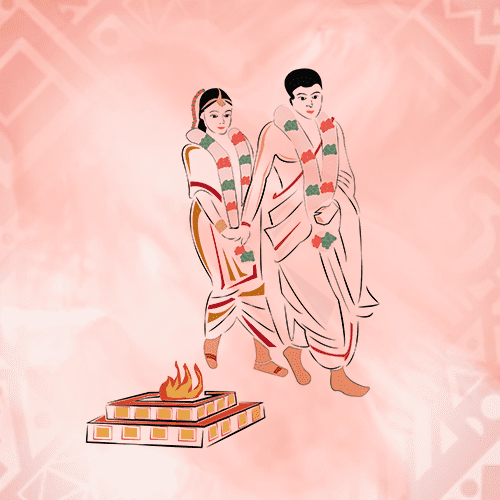
Kasi Yatra ritual is a traditional event where the groom pretends to leave for Kasi (Himalayas) to gain more knowledge and become a saint instead of entering the Grihastha Ashrama (married life). The bride's father convinces him that the path to salvation and Moksha is taking up the second stage of life which is the Grihasthashram. He talks of how the daughter will make a great partner for his Vedic rituals and soul mate who will help in his spiritual journey.
As the groom and the bride's father come back, the bride approaches the groom ready to get married.
Maalai Maatrudal means ‘exchange of garlands’. The couple exchanges garlands three times. The families and friends make it difficult by pulling the bride and groom back when they try to garland to each other. The maternal uncles assist the bride and groom in garlanding each other.
A special tune ‘maalai maatrinaal kothai maalai maatrinaal’ - a song that was specially composed for this is sung announcing the ‘garland exchange’ ritual to the gathering.
Once the ceremony is completed, the bride and groom are guided towards the ‘swing’ for the ‘oonjal’.


Oonjal is one ceremony that is a delight for everyone who is involved in the wedding. The swing which is called Oonjal in Tamil is where the bride and groom will be seated. The swing is decorated beautifully with flowers. In this ritual, the bride is assumed to be a representation of Radha and the groom that of Krishna and their feet are washed with milk. The couple are made to sit on the swing, are rocked back and forth gently, and the women in the family sing songs to celebrate the occasion. The swing represents the strength that the couple has to find in each other throughout their lives. It also serves as a reminder to have each other's back during hard times.
A handful of coloured rice is taken and is circled around the bride and groom and is thrown in all four directions of the couple, towards the left, right, front and back. The couple is protected from kan drishti (evil eye). The elders of the family take turns to bless the couple.
The word Kanyadhanam means that the precious unmarried daughter of the family handed over to the groom. The word ‘Kanya’ means unmarried girl, ‘Daanam’ means giving away (donating).
The bride sits on the lap of her father who holds a ‘thamboola’ (betel leaves and areca nut) in his palms. She then places her palms holding a coconut on her father’s palms. As the groom receives the bride’s hand from her father, the bride’s mother pours water over her daughter’s hand which is made to fall the ground like a ‘dhaara’. This ritual is called ‘dhaarai vaarthu kodukkal’ in Tamil. The mantras recited by the bride’s father symbolize the groom as an embodiment of Lord Vishnu. The Gothra of the bride is changed to that of the groom.
The groom then gives the ‘Koorai podavai’ – a customary nine-yard red colored saree to the bride. The groom's sister takes the bride to drape her in Koorai Podavai for Mangalya dhaaranam.


Mangalya dharanam in Tamil means that it is the time or moment when the mangalyam (thali) is tied around the neck of the bride by the groom.
The bride returns draped in the Koorai Podavai and sits on her father’s lap once again. The ‘Mangalya’ or ‘Mangal sutra’ refers to twin pieces of gold (one given by her father and one by the groom’s family) designed as per the family custom of the groom. It is arranged on a yellow-coloured string/thread that is tied around the bride’s neck in three knots. The groom ties the first knot of the Mangalya around the neck of the bride while his sister ties the remaining two knots.
Tying of the Mangalya is done amidst the crescendo of the ‘Nadaswaram’ and ‘Ketti melam’ as the relatives and invitees shower ‘akshadhai’ {rice smeared in turmeric) and flowers on the newlyweds.
The groom ties a rope made of ‘dharba’ grass around the bride’s hip praying for her to be blessed with good health, children, wealth, and prosperity. He leads the bride holding her right hand and sits in front of Agni (sacred fire). The groom’s sister adorns the bride with silver toe-rings (Metti in Tamil).
‘Sapta’ means seven and 'Padi' means steps. After the Thali is tied, the newlyweds take seven steps around the holy fire or Agni Kundam.
While going around the seven steps, the groom chants mantras at each step, which have the following meaning:
After taking the seven steps, the groom recites a few more mantras which means
With this the wedding is sanctified and complete. After this ritual is complete the groom and bride are declared husband and wife both socially and religiously.
